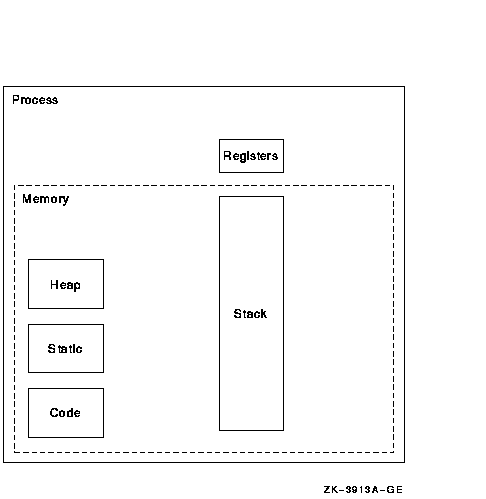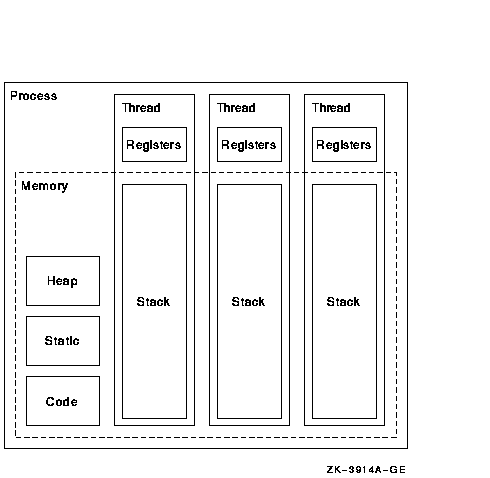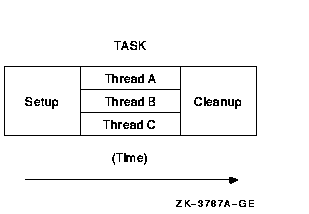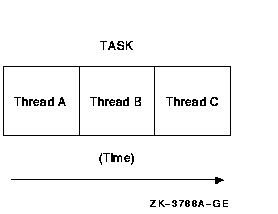![[Compaq]](../../images/compaq.gif)
![[Go to the documentation home page]](../../images/buttons/bn_site_home.gif)
![[How to order documentation]](../../images/buttons/bn_order_docs.gif)
![[Help on this site]](../../images/buttons/bn_site_help.gif)
![[How to contact us]](../../images/buttons/bn_comments.gif)
![[OpenVMS documentation]](../../images/ovmsdoc_sec_head.gif)
| Document revision date: 19 July 1999 | |
![[Compaq]](../../images/compaq.gif) |
![[Go to the documentation home page]](../../images/buttons/bn_site_home.gif)
![[How to order documentation]](../../images/buttons/bn_order_docs.gif)
![[Help on this site]](../../images/buttons/bn_site_help.gif)
![[How to contact us]](../../images/buttons/bn_comments.gif)
|
![[OpenVMS documentation]](../../images/ovmsdoc_sec_head.gif)
|
|
Order Number: AA--QSBPC--TE
This guide reviews the principles of multithreaded programming, as reflected in the IEEE POSIX 1003.1c-1995 standard, and provides implementation guidelines and reference information for DECthreads, Compaq's Multithreading Run-Time Library.
Revision/Update Information: This manual supersedes the Guide to DECthreads, Version 7.1.
Software Version:
OpenVMS Alpha Version 7.2
OpenVMS VAX Version 7.2
Compaq Computer Corporation
Houston, Texas
Compaq Computer Corporation makes no representations that the use of its products in the manner described in this publication will not infringe on existing or future patent rights, nor do the descriptions contained in this publication imply the granting of licenses to make, use, or sell equipment or software in accordance with the description.
Possession, use, or copying of the software described in this publication is authorized only pursuant to a valid written license from Compaq or an authorized sublicensor.
Compaq conducts its business in a manner that conserves the environment and protects the safety and health of its employees, customers, and the community.
© Compaq Computer Corporation 1999. All rights reserved
The following are trademarks of Compaq Computer Corporation: Alpha, AlphaServer, Bookreader, Compaq, DEC, DEC Ada, DECdirect, DECthreads, DIGITAL, DIGITAL UNIX, Ladebug, OpenVMS, OpenVMS Cluster, ULTRIX, VAX, VAX Ada, VAX DOCUMENT, VAX MACRO, VAXcluster, VMS, and the Compaq logo.
The following are third-party trademarks:
IEEE and POSIX are registered trademarks of the The Institute for Electrical and Electronics Engineers, Inc.
Microsoft, MS, MS--DOS, Win32, and Windows NT are registered trademarks and Windows 95 is a trademark of Microsoft Corporation.
Motif, OSF, OSF/1, and OSF/Motif are registered trademarks and Open Software Foundation is a trademark of the Open Software Foundation, Inc.
UNIX is a registered trademark in the United States and other countries, licensed exclusively through X/Open Company Ltd.
All other trademarks and registered trademarks are the property of their respective holders.
ZK6493
The OpenVMS documentation set is available on CD-ROM.
This document was prepared using VAX DOCUMENT, Version V3.2n.
| Contents | Index |
This guide is for system and application programmers who use DECthreads to create multithreaded applications or to create thread-safe code libraries that can be called from single-threaded or multithreaded applications.
This guide consists of the following:
For additional information on the Open Systems Software Group (OSSG) products and services, access the following OpenVMS World Wide Web address:
http://www.openvms.digital.com |
Compaq welcomes your comments on this manual.
Print or edit the online form SYS$HELP:OPENVMSDOC_COMMENTS.TXT and send us your comments by:
| Internet | writer@dceidl.enet.dec.com |
| Fax | 603 884-0120, Attention: Core Technology Group, ZKO2-3/Q18 |
|
Core Technology Group, ZKO2-3/Q18
110 Spit Brook Rd. Nashua, NH 03062-2698 |
Use the following World Wide Web address to order additional documentation:
http://www.openvms.digital.com:81/ |
If you need help deciding which documentation best meets your needs, call 800-DIGITAL (800-344-4825).
VMScluster systems are now referred to as OpenVMS Cluster systems. Unless otherwise specified, references to OpenVMS Clusters or clusters in this document are synonymous with VMSclusters.
The following conventions are used in this manual:
| ... |
A horizontal ellipsis in examples indicates one of the following
possibilities:
|
|
.
. . |
A vertical ellipsis indicates the omission of items from a code example or command format; the items are omitted because they are not important to the topic being discussed. |
| ( ) | In command format descriptions, parentheses indicate that you must enclose the options in parentheses if you choose more than one. |
| [ ] | In command format descriptions, brackets indicate optional elements. You can choose one, none, or all of the options. (Brackets are not optional, however, in the syntax of a directory name in an OpenVMS file specification or in the syntax of a substring specification in an assignment statement.) |
| [|] | In command format descriptions, vertical bars separating items inside brackets indicate that you choose one, none, or more than one of the options. |
| { } | In command format descriptions, braces indicate required elements; you must choose one of the options listed. |
| text style |
This text style represents the introduction of a new term or the name
of an argument, an attribute, or a reason.
In the HTML version of this document, this convention appears as italic text. |
| italic text | Italic text indicates important information, complete titles of manuals, or variables. Variables include information that varies in system output (Internal error number), in command lines (/PRODUCER= name), and in command parameters in text (where dd represents the predefined code for the device type). |
| UPPERCASE TEXT | Uppercase text indicates a command, the name of a routine, the name of a file, or the abbreviation for a system privilege. |
Monospace type |
Monospace type indicates code examples and interactive screen displays.
In the C programming language, monospace type in text identifies the following elements: keywords, the names of independently compiled external functions and files, syntax summaries, and references to variables or identifiers introduced in an example. |
| - | A hyphen at the end of a command format description, command line, or code line indicates that the command or statement continues on the following line. |
| numbers | All numbers in text are assumed to be decimal unless otherwise noted. Nondecimal radixes---binary, octal, or hexadecimal---are explicitly indicated. |
This chapter introduces the concepts of threads and multithreaded programming. It describes four functional models that can be a basis for constructing multithreaded applications. The concepts and techniques introduced here are described in more detail in Chapter 2 and in this guide's platform-specific appendixes.
This chapter's last section introduces the components of the DECthreads
package, in particular the pthread and
tis interfaces, and how those components support
building multithreaded applications and thread-safe libraries.
1.1 Advantages of Using Threads
Multithreaded programming means organizing and coding a program so that instances of its routines, called threads, can execute concurrently in the same process. You use threads to improve a program's performance---that is, its throughput, computational speed, responsiveness, or some combination.
Using threads can improve a program's performance on uniprocessor systems by permitting the overlap of input, output, or other slow operations with computational operations. Threads are useful in driving slow devices such as disks, networks, terminals, and printers. A multithreaded program can perform other useful work while waiting for the device to produce its next event, such as the completion of a disk transfer or the receipt of a packet from the network.
Using threads can also be advantageous when constructing an application's user interface. Consider the typical arrangement of a window system. Each time the user invokes an action (for example, by clicking on a mouse button), the program can use a separate thread to implement the action. If the user invokes multiple actions, multiple threads can perform the actions in parallel.
Using threads is especially advantageous when building a distributed system. These systems frequently contain a shared network server, where the server services requests from multiple clients. Using multiple threads allows the server to handle clients' requests in parallel, instead of artificially serializing them or creating (at great expense) one server process per client.
A program with multiple threads can be especially suited to run on a
multiprocessor system, where threads run concurrently on separate
processors. Threads created using the DECthreads library are capable of
utilizing multiprocessors, if the target platform supports parallelism
within a process. Compaq's DIGITAL UNIX platforms and OpenVMS Alpha
platforms support parallelism; the OpenVMS VAX platform does not
support parallelism.
1.2 Overview of Threads
A thread is a single, sequential flow of control within a process. Within each thread there is a single point of execution. Most traditional programs execute as a process with a single thread. Figure 1-1 and Figure 1-2 show the differences between a single-threaded process and a multithreaded process.
Figure 1-1 Single-Threaded Process

In Figure 1-2, notice that multiple threads share heap storage, static storage, and code but that each thread has its own register set and stack.
Using DECthreads, Compaq's multithreading run-time library, a programmer can create several threads within a process. The process's threads execute concurrently. Within a multithreaded program there are at any time multiple points of execution.
Threads execute within (and share) a single address space; therefore, a process's threads can read and write the same memory locations. When the threads access the same memory locations, your program must use synchronization elements, such as mutexes and condition variables, to ensure that the shared memory is accessed correctly. DECthreads provides routines that allow you to use these and other synchronization objects. Section 2.4 describes the synchronization objects that DECthreads offers as well as the operations your program can perform on them.
Figure 1-2 Multithreaded Process

You should design and code a multithreaded program with the assumption that its threads execute simultaneously. That is, your program cannot make assumptions about the relative start or finish times of its threads or the sequence in which they execute. These are governed by the DECthreads thread scheduler, part of the run-time environment that DECthreads establishes before your program begins running. Nevertheless, your program can influence how DECthreads schedules its threads, by setting each thread's scheduling policy and scheduling priority. ( Section 2.3.6 describes how thread scheduling works.)
Each thread has its own thread identifier, which distinguishes it from all other threads in the process. In addition to the thread's scheduling policy and scheduling priority, each thread is associated with any thread-specific instances of thread-common data objects and with thread-specific system resources to support a flow of control.
A thread changes its state over the course of its execution. A thread is in one of the following states:
Figure 1-3 shows the transitions between states for a typical thread implementation.
Figure 1-3 Thread State Transitions

Building your multithreaded program must produce executable code that is reentrant. Therefore, be sure that your compiler generates reentrant code before you design or code your multithreaded program. By default, Compaq's C, C++, Ada, Pascal, and BLISS compilers generate reentrant code. If you cannot build your program so that its executable code is reentrant, it might be impossible to keep the program's threads from interfering with each other. See Section 3.9.1 for more information about thread-reentrant libraries. In general, when using threads, be aware of language-based programming practices that are inherently not thread safe. ("Thread safety" is explained in Section 3.9.2.) You must address these factors when writing multithreaded applications and thread-safe libraries. For example, Fortran language routines typically rely heavily upon static storage, which can prevent those routines from being thread safe. |
The following sections describe four functional models of processing information that are especially well suited for implementation in multithreaded programs:
In a boss/worker model, one thread functions as the "boss" because it assigns tasks for "worker" threads to perform. Each worker performs a distinct task until it has finished, at which point it notifies the boss that it is ready to receive another task. Alternatively, the boss polls workers periodically to see whether any is ready to receive another task.
A variation of the boss/worker model is the work queue model. The boss places tasks in a queue, and workers check the queue and take tasks to perform.
An example of the work queue model in an office environment is a
secretarial typing pool. The office manager boss puts documents to be
typed in a basket, and worker typists take documents from the basket to
work on.
1.4.2 Work Crew Model
In the work crew model, multiple threads work together on a single task. The task is divided into pieces that are performed in parallel, and each thread performs one piece.
An example of a work crew is a group of people cleaning a building. Each person cleans certain rooms or performs certain types of work (washing floors, polishing furniture, and so forth), and each works independently.
In a multithreaded program that reflects the work crew model, each thread executes a task that can be performed in parallel. Figure 1-4 shows a task performed by three threads in a work crew model.
Figure 1-4 Work Crew Model of Thread Operation

In the pipelining model, a task is divided into steps. The steps must be performed in sequence to produce a single instance of the desired result, and the work done in each step (except for the first and last) is based on the previous step and is a prerequisite for the work in the next step. However, the goal is to produce multiple instances of the desired result, and the steps are designed to operate in parallel: while one step is performed on one instance of the result, the preceding step can be performed on the next instance of the result.
An example of the pipelining model is an automobile assembly line. Each step or stage in the assembly line is continually busy receiving the product of the previous stage's work, performing its assigned work, and passing the product along to the next stage.
In a multithreaded program that reflects the pipelining model, each thread executes a step in the task. Figure 1-5 shows a task performed by three threads in a pipelining model.
Figure 1-5 Pipelining Model of Thread Operation

If the task that your program performs is complex, you might find it
appropriate to organize it as a combination of the functional models
previously described. For example, a program could follow the
pipelining model, but with one or more steps performed by a set of
threads that follow a work crew model. In addition, threads could be
assigned to a work crew by taking a task from a work queue and deciding
(based on the task characteristics) which threads are needed for the
work crew.
1.5 Potential Issues for Multithreaded Programs
When you design and code a multithreaded program, you must accommodate or eliminate, as appropriate, each of the following issues:
| Next | Contents | Index |
![[Go to the documentation home page]](../../images/buttons/bn_site_home.gif)
![[How to order documentation]](../../images/buttons/bn_order_docs.gif)
![[Help on this site]](../../images/buttons/bn_site_help.gif)
![[How to contact us]](../../images/buttons/bn_comments.gif)
|
| privacy and legal statement | ||
| 6101PRO.HTML | ||